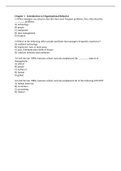Samenvatting
Samenvatting Skills tentamen JASP - ARMS Advanced Research Methods and Statistics ()
Dit document omvat een volledige samenvatting van de benodigde kennis voor het skills tentamen van ARMS. Zo beschrijft het o.a. hoe je analyses kunt doen en welke assumpties je hierbij test. This document entails a complete summary of all the knowledge needed for the skills test of ARMS. It des...
[Meer zien]










